Audio-Technica ATH-CKS50TW
MSRP $149.00
“Audio-Technica nails the performance-and-features value for money formula.”
Pros
- Great sound with massive bass
- Huge battery capacity
- Very good noise cancellation
- Bluetooth Multipoint
- IPX4 water resistance
- aptX Adaptive
Cons
- No wireless charging
- No wear sensors
- Bulky charging case
Audio-Technica (A-T) is best known for its studio-grade but highly affordable wired headphones and its turntable cartridges. But the Japanese brand also is carving out a nice niche for itself in the wireless earbuds world. Its latest effort — the $149 ATH-CKS50TW (yup, like all A-T models, it’s a mouthful) — follow that same formula, and can be considered the opposite of Apple’s iconic AirPods, in nearly every meaningful way. They only come in black, they’re huge, they have an astounding amount of battery life, and when it comes to bass, I don’t think there’s anything else like them.
How do these bodacious buds stack up to the competition? Let’s check ‘em out.
Design
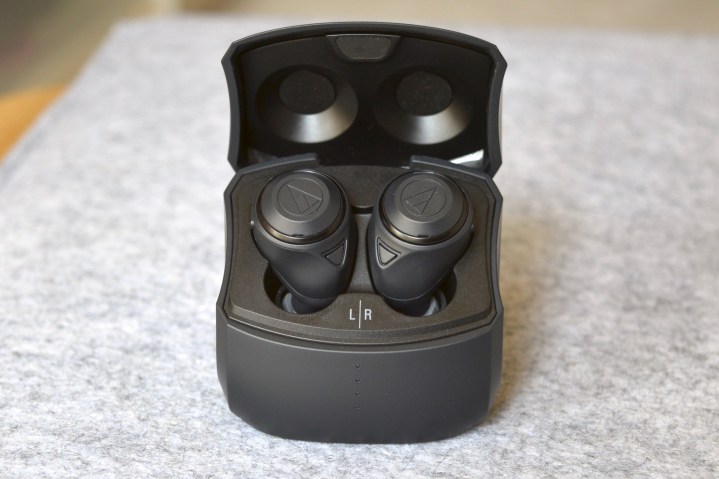
Audio-Technica’s aesthetic is a blend of form-meets-function. I’d hardly call the company’s headphones stylish, but they do possess a purposeful, no-nonsense quality I admire. The ATH-CKS50TW (which I will from here on out call the CKS50 for your sanity and mine) follow that same approach, with an almost monolithic (and monotone) design. They’re chunky — despite their rounded contours — something which all the beveled edges in the world can’t disguise.
Instead of the more common touch controls, A-T uses physical buttons on its earbuds, which are positioned on the top edge, where they’re easy to access. That’s a bit of a departure from the usual placement on the front, circular panel, but perhaps that room was required for the drivers and massive batteries.
With Bluetooth Multipoint support, you can keep two paired devices active simultaneously, like a PC and a phone.
You won’t want to take the CKS50 to the beach, but their IPX4 rating for water resistance should keep them safe from the ravages of sweat and rain as long as you clean them after each use.
Their charging case is also a bulky affair, and while it will easily find a home in a gym bag or backpack, you’re asking for some funny looks if you cram it in your pocket. Ordinarily, I’d assume the size was related to the battery within, but as I’ll explain later, that doesn’t quite add up.
On the bright side, A-T has used that size to make the CKS50 very accessible. The giant flip-top lid gets completely out of your way, and the earbuds sit facing slightly forward, making them easy to grab and replace.
The case’s flat bottom lets you stand it upright on any flat surface, but there’s no wireless charging. With the CKS50’s big battery, that’s a lot less of an inconvenience.
Comfort, controls, and connections
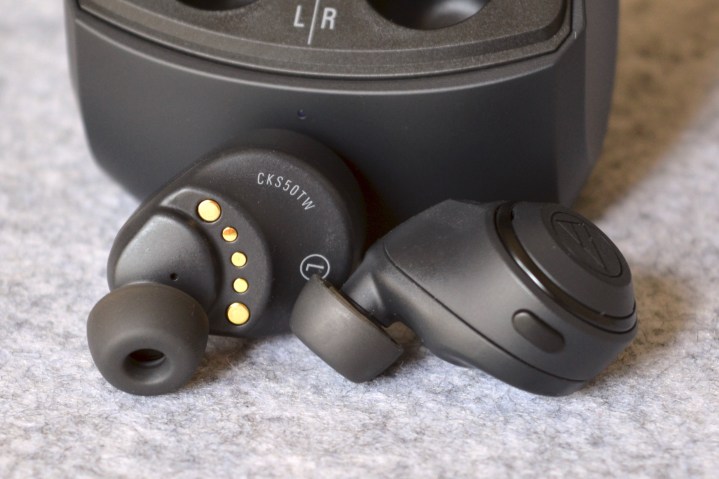
The CKS50’s big size means those with small ears are going to have issues with fit. They’re not quite as large as Sony’s mammoth WF-1000XM4, but close. Still, as long as your ears can accommodate them, they’re a very comfortable shape, with a gently tapering horn. A-T provides four sizes of silicone ear tips to help you get a good seal, and I found the default mediums were ideal for me.
I was pleasantly surprised that despite their size, once firmly seated they stayed put, even during a workout. And they were comfortable enough to wear for up to two hours before I needed a break.
The multifunction control buttons on each bud are easy to reach and in addition to the tactile feedback, you get a short tone to confirm whether you’ve single-, double-, or triple-clicked. Unfortunately, there’s very little travel on the buttons and they’re a bit mushy, making multi-click commands a bit tricky.
Using lossless hi-res tracks, it became apparent that aptX Adaptive was delivering a higher quality signal.
Still, they provide everything you need, including play/pause, track skip forward/back, call answer/end, and volume up/down. If you download the A-T Connect app for iOS/Android, you also get the ability to customize the long-press function for each earbud, with these choices: Voice assistant access, quick hear-through, low-latency mode, ANC control, or no action. By default, these are set to ANC control on the left bud and quick hear-through on the right. I’ll discuss these features more in a moment.
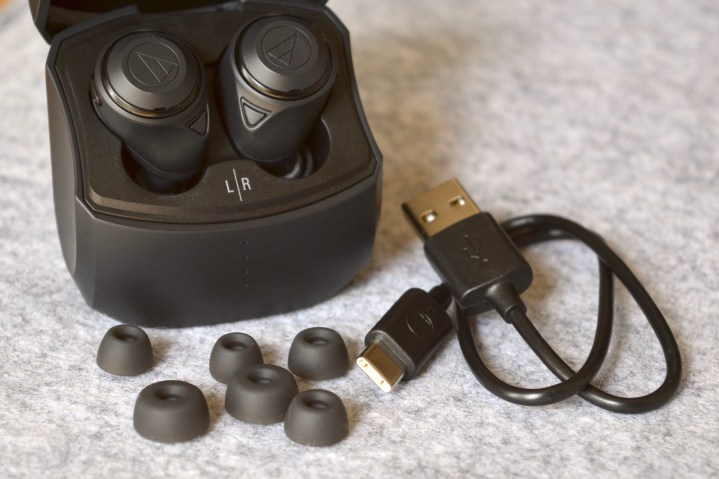
By default, the buds will give you voice feedback for functions, e.g. “Play,” “pause,” etc., but you’ll probably want to disable these in the app as they actually slow down the response times for each function and they’re really not necessary.
The one thing missing here is auto-pause. The earbuds aren’t equipped with wear sensors, so they can’t stop and start your tunes as you remove and replace them.
The A-T Connect app does a superb job of letting you manage connected devices.
With Google Fast Pair, getting Android devices connected is a cinch, but even getting the CKS50 paired with iOS devices is still very quick and easy. Thanks to Bluetooth 5.2, the connection is strong and very reliable — I had no dropouts at all while testing. Better yet, with Bluetooth Multipoint support, you can keep two paired devices active simultaneously, like a PC and a phone, and switch between them seamlessly.
The A-T Connect app does a superb job of letting you manage connected devices, showing which ones are active and connected, which ones you’ve connected to previously, and gives you the ability to put the earbuds into pairing mode remotely so you can add additional devices without needing to futz around with the earbuds’ controls. It’s the best multi-device support I’ve seen in a companion app so far. And yes, you can use each earbud independently for both calls and music, but you can’t split them up between paired devices.
Sound quality
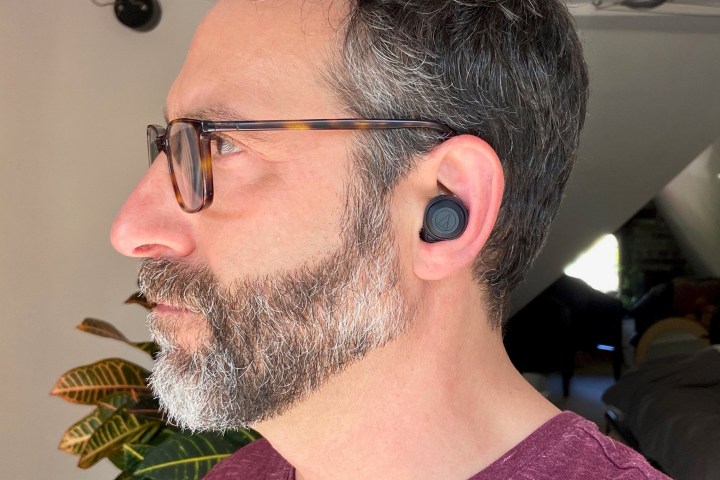
True to Audio-Technica’s reputation for audio quality, the CKS50 sound great. The factory tuning is big on bass — dramatically so. I have a lot of love for earbuds and headphones with powerful low-end performance (like the teeth-rattling JVC HA-XC90T) and I can’t remember the last time I felt overwhelmed by it, but the CKS50 had me searching for the EQ adjustments in the A-T Connect app immediately.
Don’t get me wrong, it’s absolutely amazing. And if you’re a bass-head, I suspect you’ll be in heaven. But I found it just too much. Fortunately, those EQ settings can make a big difference. There are helpful presets, like clear vocal and treble enhance (and even a bass boost if you dare), but you can also use the five-band sliders to create and save your own balance. What needs no tweaking is the overall performance. There’s tons of definition and clarity in the midranges, the soundstage is generous in its width and precision, and vocals are clear and crisp — though these were also improved with EQ modifications.
Having Bluetooth Multipoint means I was able to connect the CKS50 to both an iPhone 11 and a Xiaomi 12 Pro simultaneously, and hop back and forth between them so I could hear the difference between the AAC codec on the iPhone and aptX Adaptive on the Xiaomi. Using lossless hi-res tracks from Amazon Music, it became immediately apparent that aptX Adaptive was indeed delivering a higher quality signal.
Dynamics were improved considerably, and little details started to emerge. On the Weeknd’s Blinding Lights, for instance, the vocals took on an airier quality, and deep, complex synthesizer notes felt clear, not fuzzy. I can’t always tell the difference between AAC and high-quality codecs like LDAC and aptX Adaptive — it recently proved quite difficult when reviewing the Sony LinkBuds S, but the Audio-Technicas benefit from it in a noticeable way.
One other impressive feature: You can decide how granular you’d like the volume control to be — from a minimum of 16 steps to a maximum of 64. I can’t recall ever seeing that option on a set of wireless earbuds before.
Noise canceling and transparency mode
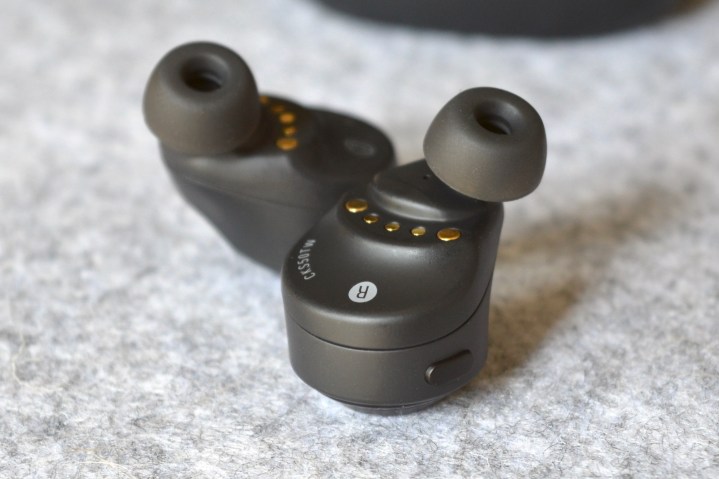
ANC on the CKS50 is excellent, providing very good reduction of most frequencies. It’s equally adept at dealing with constant, droning sounds like bathroom fans or air conditioners, as it is with intermittent and variable noise like traffic.
I had no problem staying focused on both podcasts and music while walking through downtown streets, and when sitting at my computer I was able to use it to just get a bit of peace and quiet for concentration.
I even had a coworker comment on how good my voice sounded, which I can tell you doesn’t happen very often.
You can pick from two kinds of transparency: Quick hear-through mutes (but doesn’t pause) your audio and lets you hear the outside world for ad-hoc conversations, while a dedicated control for ANC lets you switch between ANC, transparency, and no function (off) for your longer-term needs. They’re both handy, but I’d like it if the A-T Connect app let you decide to just switch between ANC and transparency instead of cycling through the off mode.
The silicone tips do a very good job of passive noise isolation, so the transparency mode is helpful, but it’s not the kind of magical feeling of not wearing any earbuds that Apple has mastered with the AirPods Pro. Still, it’s better than nothing.
Call quality
Overall, calling on the ATH-CKS50 is very good. Like most wireless earbuds, they struggle a bit with canceling background noise, but what I like is that they don’t distort your voice as they do so. Instead, there’s a slight loss of microphone gain — you sound quieter and farther away.
But get them in a quieter location and your voice will sound clear and very natural, with plenty of resonance. I even had a coworker comment on it during a Microsoft Teams call, which I can tell you doesn’t happen very often.
There’s a selectable side-tone option in the app, but if there’s one weakness to calling on these buds, it’s that even with side-tone turned on, your voice will still sound a bit muted to your own ears — definitely not what you’d get with the AirPods Pro, or the Jabra Elite 7 Pro, both of which offer excellent voice feedback.
Battery life
As I hinted above, the ATH-CKS50 have an absolutely monstrous battery capacity in the earbuds — a claimed 20 hours. Granted, that’s with ANC disabled, but even when it’s on, A-T says you can expect 15 hours — still huge by wireless earbud standards.
And from what I can tell, these aren’t exaggerated numbers. What I can’t quite figure out is why the charging case only holds an additional 30 hours. Don’t get me wrong, that’s a really big figure too, it’s just the proportions that seem skewed to me.
For comparison, the AirPods Pro last about five hours on a charge, and their tiny case can recharge them about four times before it dies and needs to be recharged itself — a fairly common ratio. The CKS50’s case is way bigger, and yet it can only recharge the earbuds about 1.5 times. It seems to me that the case should be able to do at least a three-times charge, which would give these buds a total play time of 80 hours.
Again, 20+30 is nothing to be sneezed at, but when you’ve got that much room to play with, why not swing for the fences? A quick-charge feature gives you an additional 90 minutes of play time with just 10 minutes in the case.
Our take
The Audio-Technica ATH-CKS50 are a superb set of noise-canceling earbuds with monster bass and monster battery life. And despite a few missing features and a charging case that is anything but pocketable, they’re an incredible value for around the $150 mark. If you’re looking for a premium set of wireless earbuds, they deserve a spot on your shortlist.
Are there better alternatives?
At this price, the CKS50TW have no competition when it comes to battery life and big, bold bass. And when you consider their many other strengths, it becomes even harder to find direct comparisons. Their closest competitors come from Anker Soundcore:
The $179 Anker Soundcore Liberty 3 Pro cost a bit more, but they offer wireless charging, wear sensors, and I think more people will find them to be a better, more comfortable fit. Sound-wise, they’re both superb and both offer Bluetooth Multipoint. But the Soundcores can’t hold a candle to the CKS50’s massive batteries, and I think Audio-Technica does a better job with ANC and controls.
The $129 Anker Soundcore Liberty Air 2 Pro also have wireless charging and wear sensors, and with the recent addition of the LDAC Bluetooth codec, they also do hi-res audio. The CKS50 still sound better overall, plus they have that huge set of batteries, and they have Bluetooth Multipoint, which the Air 2 Pro lack.
How long will they last?
It’s always hard to evaluate this with wireless earbuds, but I’m going to go out on a limb here and say that the ATH-CKS50 will last longer than most other models. I say that for two reasons: One, like all Audio-Technica products, build quality is excellent. But two, and arguably the more important reason, is their huge battery capacity. Every time you recharge a battery, its capacity drops by a very small amount. The math is simple; the bigger a battery’s initial capacity, the longer it will provide a useful amount of power. E.g. if a set of earbuds loses 50% of its total playtime after 500 recharges (I made that number up), then that means a set of AirPods Pro will die after about 2.5 hours of use, while the CKS50 will still have a huge 7.5-10 hours depending on ANC usages.
Should you buy them?
Yes. The ATH-CKS50 don’t nail the entire wireless earbud formula, but they deliver the stuff that most people will care about: Sound quality, battery life, ANC, and excellent app-based settings, and they do it for a very reasonable price.
Editors’ Recommendations

